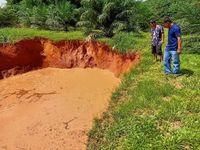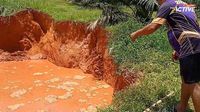On April 20, 2025, residents of Krabi Province, Thailand, were alarmed by the emergence of a large sinkhole in a palm oil plantation located in Village No. 10 of Tambon Khao Phanom. The sinkhole, which measured approximately 20 meters wide and 10 meters deep, raised concerns about the geological stability of the area following a recent earthquake.
The sinkhole was discovered just a day after a magnitude 6.3 earthquake struck the region on April 14, 2025. This earthquake was felt across several provinces, including Surat Thani, where the Disaster Prevention and Mitigation Office reported damage and flooding in various areas. The earthquake's tremors are believed to have triggered the ground subsidence in Krabi, a region known for its limestone geology, which can create underground voids susceptible to collapse.
According to Mr. R.S. Sutthisakdi Srilump, head of the Disaster Prevention and Mitigation Office of Krabi Province, local authorities, including geologists and disaster management teams, have been dispatched to investigate the sinkhole's formation and its possible link to the earthquake. "We are examining whether this sinkhole is directly related to the seismic activity that occurred last week," Sutthisakdi stated.
During the inspection, officials noted that the sinkhole had not only formed a large cavity but also caused numerous cracks in the surrounding soil, covering an area of more than four rai. This prompted immediate assessments of the risk to nearby homes and infrastructure. Mr. Thanit Srisamatsakdi, a disaster prevention specialist, emphasized that the geological conditions in the area, particularly the presence of limestone, could exacerbate the situation. "When earthquakes occur, they can destabilize the ground, especially in areas with pre-existing voids, leading to sinkholes," he explained.
Residents have been urged to remain vigilant as further ground subsidence may occur. The local government plans to educate the community about disaster preparedness and response strategies to mitigate future risks. "It’s crucial for local authorities to have the knowledge and resources to manage these situations effectively," said Sutthisakdi.
The sinkhole incident is not isolated. Historical records indicate that similar occurrences have happened in the region, particularly after significant seismic events. For instance, a previous earthquake in Mae Lao, which registered a magnitude of 6.3, also resulted in sinkholes in agricultural fields. These geological phenomena are more common in areas with limestone formations, where underground cavities can develop over time.
In light of the recent flooding and the sinkhole's emergence, Mr. Thanaphon Rampaeng, the head of Village No. 10, has called for a comprehensive survey of the affected areas to assess damage and provide relief to impacted households. "We need to coordinate with disaster management teams and the Royal Irrigation Department to expedite water drainage and ensure the safety of our residents," Rampaeng stated.
Heavy rainfall on April 19, which followed the earthquake, exacerbated the situation, causing water levels to rise significantly in various parts of Krabi. Reports indicated that some areas experienced flooding up to 10 meters deep, affecting approximately 280 households in the region. The flooding was primarily attributed to drainage issues rather than the earthquake itself, although the seismic activity may have contributed to the overall instability of the land.
Local geologists are currently working with the Department of Mineral Resources to analyze the sinkhole's characteristics and determine the extent of any underground cavities. "We are using geophysical measurement tools to assess the size and depth of the voids beneath the surface," said Mr. Thanit. This assessment is crucial for understanding the potential for further ground collapse and ensuring the safety of the local population.
The geological conditions in Krabi, characterized by its limestone bedrock, make the area particularly susceptible to sinkholes, especially following seismic events. As Sutthisakdi pointed out, "The occurrence of sinkholes is a natural phenomenon in regions with limestone geology, and it can be triggered by various factors, including earthquakes and changes in groundwater levels."
As the investigation continues, local authorities are emphasizing the importance of community awareness and preparedness in the face of natural disasters. Educational programs are being developed to inform residents about the signs of potential geological hazards and the steps they can take to protect themselves and their properties.
In conclusion, the recent sinkhole in Krabi serves as a stark reminder of the geological risks faced by communities in seismically active regions. With ongoing assessments and community engagement, local officials aim to enhance disaster resilience and ensure the safety of residents in the face of future geological events.





